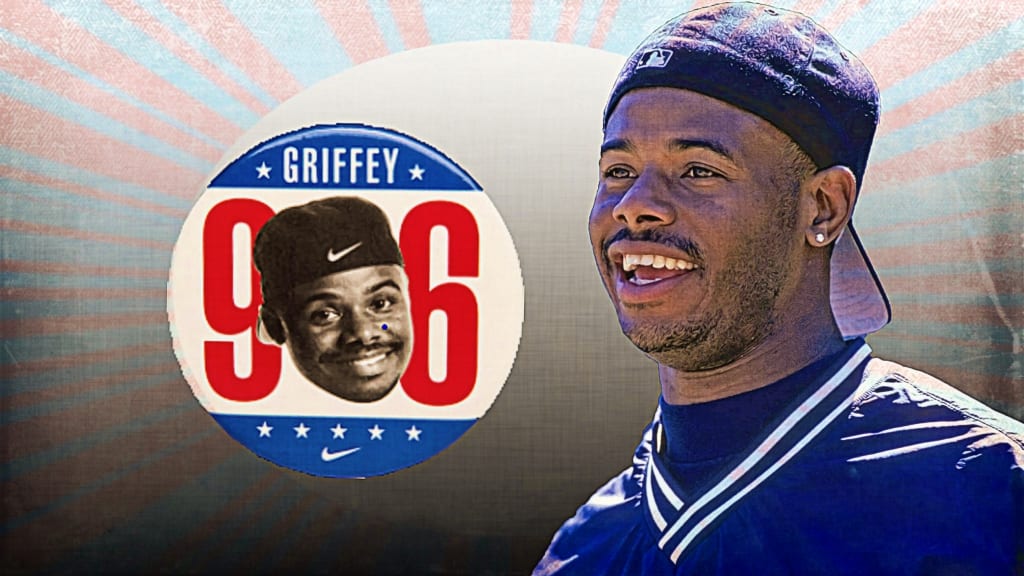
Any day is a good day to look back on the incredible talent, flair and history of Ken Griffey Jr.’s Hall of Fame career, so Monday’s landmark day in the sneaker world -- with Nike re-releasing the iconic Griffey Air Max 1 sneaker that he rocked back in 1996 -- offered the perfect excuse to do just that.
But there was also some fitting -- if unintentional -- symmetry involved with Griffey’s shoe hitting the market on Presidents Day. Why? Because “The Kid” is now 25 years removed from running a U.S. presidential campaign of his own.
Back in 1996, Griffey had become so popular that Nike saw an opportunity to tie in its baseball superstar with the biggest popularity contest of them all: the presidential election. Alongside the incumbent Bill Clinton, Bob Dole, Ross Perot and many more, candidate Griffey threw his hat into the ring (metaphorically speaking, of course) with a fictional ad campaign.
There were television commercials, there were campaign buttons and there was starpower. Griffey’s campaign staff got a major boost with the addition of campaign manager George Clinton -- yes, that George Clinton, of Parliament-Funkadelic music group fame. The legendary singer thought Griffey could bring a lot to the table.
“Junior has everything you look for in a President,” Clinton explained. “The power of a young Teddy Roosevelt, combined with the throwing arm of a Roberto Clemente. He knows what this country needs.
“My name might be Clinton,” he continued, “but I know what I’m talking about. Vote Griffey.”
For The Kid, the path to the White House wasn’t easy. For one, he had a day (and night) job, trying to lead the Mariners back to the playoffs after he and Edgar Martinez had carried Seattle to its first October appearance the year before. The U.S. Constitution was another hurdle; it states that the President must be at least 35 years of age, and Griffey was only 26.
So there were barriers, sure, but some major names from the political world were still inspired by Griffey’s platforms of more home runs and endless games of pepper. Political strategist James Carville, who had successfully advised President Bill Clinton’s victory just four years before, seemingly switched to the outsider Griffey over the incumbent.
“People don’t want someone coming out of left field,” said Carville, a Democrat, in one Nike ad, “And they sure don’t want someone who plays too far right. Griffey’s in the center [field], perfectly positioned.”
Griffey tabbed the Mariners’ mascot, Moose, to be his running mate -- a move Clinton said showed “his consideration for animal rights.” He also displayed strong electability among Hall of Famers.
“He is a fabulous American hero,” said Mr. October, Reggie Jackson, of the man hoping to win in November, “and there hasn’t been anyone like him since, well, Reggie Jackson."
As for the snappiest soundbyte from the campaign, leave it to candidate Griffey himself when he said, “We need someone who can hit a Mark Langston overhand curveball.”
Ultimately, Griffey’s “bid” had to come as a third-party candidate. Bill Clinton, as expected, was re-nominated for the Democratic ticket, while Bob Dole carried the Republican primaries. But as the summer wore on, "Griffey in ’96" bumper stickers began popping up on highways, as did roadside rallies in battleground states. On the diamond, Griffey was delivering on his home run promise, smashing his way to a then-career high 49 round-trippers. Meanwhile, Nike copywriter Hank Perlman was seeing a perfect opportunity for baseball to represent the desires of American voters.
"Consciously or subconsciously, we are holding up a mirror to the political process and the way that pop culture and politics comes together in our country," Perlman told The Washington Post. "We want people to write in [Griffey’s] name. I think we'll do well in the South, I'll think we'll do well in Seattle."
But despite his overwhelming popularity, Griffey, like any presidential candidate, had his detractors. Said Republican candidate Steve Forbes, “I think Ken Griffey is spending too much time on the field, and not enough time on issues, like the flat tax.” And rapper Ice-T dismissed Junior’s campaign as “nothin’ but a big marketing scheme” (though Nike Chairman Phil Knight quickly downplayed that notion).
Maybe Griffey’s biggest challenge of all came from within his own party (the baseball party, that is), when Nike’s rival, Fila, put forth its own candidate: Hall of Famer Eddie Murray. In the first national ad appearances of his career, the quiet Murray let a voice-over narration do the talking in a series of “attack ads” against the younger slugger.
“Fact: In 1977, Eddie was putting on his first uniform,” said one commercial. “His opponent? His jammies.”
In the end, the Griffey-Murray rivalry was a win-win. Nike enjoyed a sales boost for the Air Max Griffeys, while Fila continued to rise in the industry. Junior didn’t win the election, as you might recall; he focused his attention on the baseball season’s stretch run, instead. But the campaign did help to raise Griffey’s national profile even further before his incredible 1997 AL MVP season and ’98 home run chase with Mark McGwire and Sammy Sosa.
Griffey even received something that not even his advisors Clinton or Carville could have envisioned: An actual write-in vote in the 1996 Rhode Island Democratic Primary. It seems at least one Rhode Islander was convinced by Griffey’s campaign mantra: “We’re not a nation of individuals, we’re one big American League.”
A version of this story originally ran on the National Baseball Hall of Fame's website in 2016.
Matt Kelly is a reporter for MLB.com based in New York.
